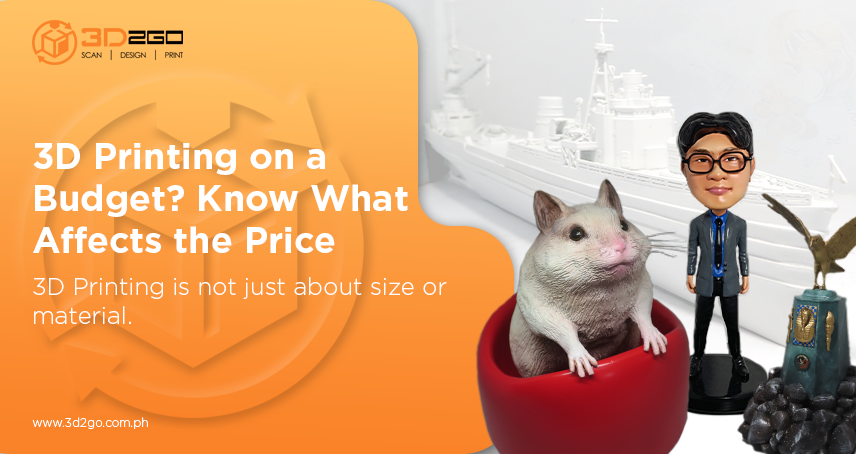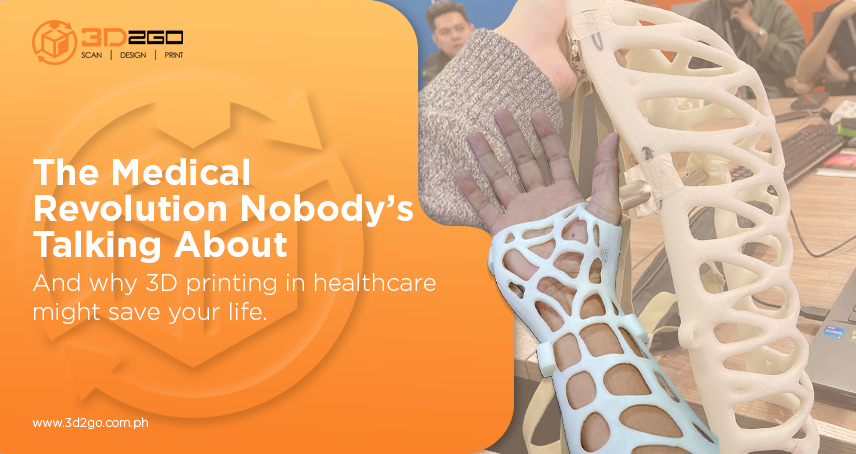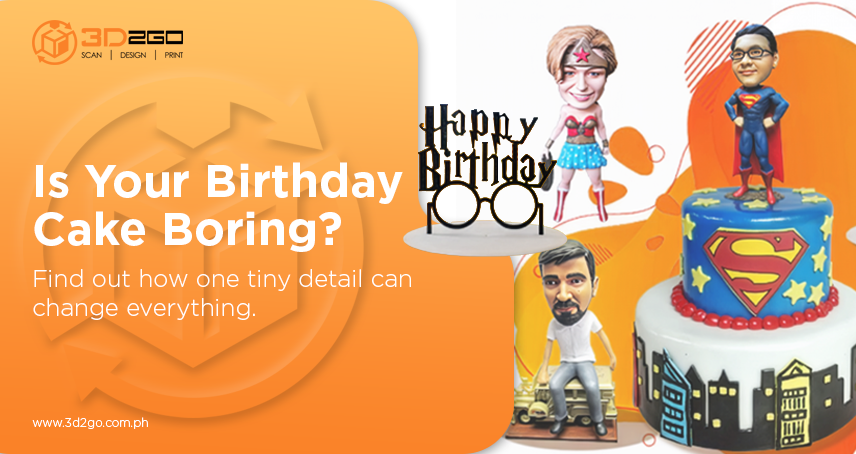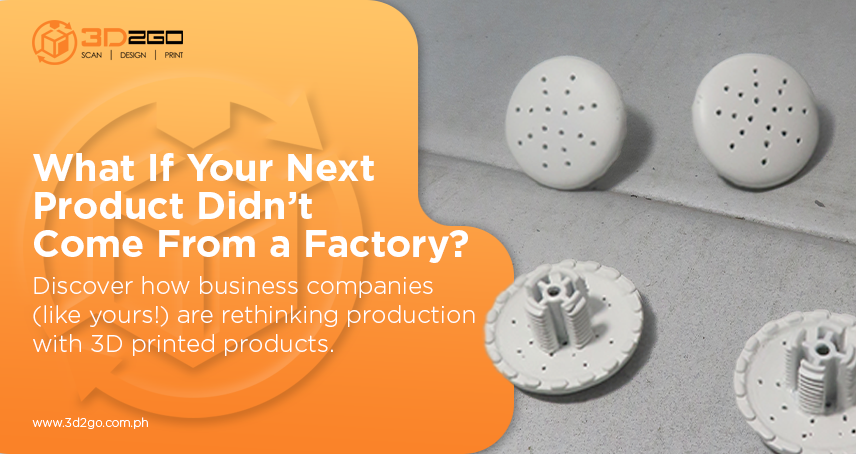
Boosting Your Customization Game with 3D Scanning Services for 3D Printing
August 14, 2025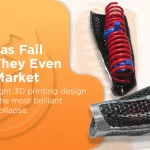
The Value of Partnering with a 3D Printing Design Service
August 20, 2025If you’ve ever tried to get something 3D printed, you’ve probably noticed that the 3d printing service cost isn’t one-size-fits-all. Some prints are surprisingly affordable, while others make you think twice before hitting “confirm order.” The truth is, the cost of 3d printing depends on more than just loading a file and pressing a button.
A lot happens before and after the print itself. Materials, design complexity, size, and even your deadline all play a part. Understanding these factors not only helps you budget better but can also save you from paying more than you should.
1. Material Type and Quality
One of the biggest contributors to 3d printing service cost is the material itself. Different projects require different properties: strength, flexibility, heat resistance, or visual appeal, and each comes at a different price point.
-
PLA (Polylactic Acid) – Affordable and biodegradable, great for simple, non-functional models.
-
ABS (Acrylonitrile Butadiene Styrene) – Durable and heat-resistant, often used for mechanical parts.
-
PETG (Polyethylene Terephthalate Glycol) – A balance of strength and flexibility, good for functional prototypes.
-
Resins – Used in SLA or DLP printing for high-detail models like figurines and dental casts; can be pricier.
-
Specialty Filaments – Such as carbon fiber-infused or metal filaments, which cost more but provide unique properties.
Tip: If you don’t need advanced material performance, choosing a more common filament can cut costs without compromising the final look.
2. Complexity Isn’t Just About Looks
A straightforward cube will cost far less to print than a highly detailed figurine or a mechanical assembly. That’s because complexity affects:
-
Design Time – If you need help preparing or modifying the model file, design services will be factored in.
-
Print Duration – Intricate models require more precise movements and slower print speeds, increasing machine time.
-
Post-Processing – Sanding, painting, or assembling multiple parts adds labor costs.
If a design has fine details, moving parts, or thin structures, the printer has to work more slowly and carefully, which drives up machine time and labor. In some cases, the file itself might need adjustments before printing, adding another layer to the 3d printing service cost.
3. Print Volume and Size
Size matters in 3D printing. Larger models require more filament and more print time. Many 3D printing services calculate part of the cost based on material weight (grams or kilograms used) and machine hours.
You might think shrinking your design is the easiest way to save money, but be careful. If you reduce the size too much, you may compromise the function or visual impact of your piece. A better strategy is to explore hollowing the model or printing it in sections to reduce wasted material.
4. Turnaround Time
Printing takes time, and so does preparing and finishing your model. When you need something right away, the provider may have to bump other jobs, run machines outside regular schedules, or dedicate more people to meet the deadline. Those rushed measures can add a premium to the 3d printing service cost.
If you can plan ahead, you can save significantly by opting for standard lead times.
5. Choosing the Right Printing Method
Not all 3D printers are created equal. The type of machine used affects both quality and price:
-
FDM (Fused Deposition Modeling) – Common, cost-effective, suitable for prototypes and larger parts.
-
SLA/DLP (Stereolithography/Digital Light Processing) – High precision, perfect for intricate details, but resin costs and post-curing add to the price.
-
SLS (Selective Laser Sintering) – Ideal for complex geometries and strong parts, often used in industrial applications, generally more expensive.
Your service provider will usually recommend the best option based on your requirements, but knowing the basics can help you understand the 3d printing service cost you’re quoted.
6. Post-Processing and Finishing
Sometimes the raw print is enough. Other times, it needs to look polished, painted, or even plated. Finishing steps that can add to the cost include:
-
Smoothing and sanding
-
Priming and painting
-
Adding textures or coatings
-
Assembly of multiple components
These steps can be worth the investment if appearance matters, say, for a presentation model or consumer-facing product.
7. File Preparation and Design Services
If you already have a perfect, print-ready file in the correct format, you’ll save both time and money. But if your file needs fixing, scaling, or even creating from scratch, design services will be added to the bill.
While this might seem like an extra cost, professional modeling ensures better print results and avoids costly reprints due to design flaws.
8. Quantity and Batch Printing
Ordering in bulk can be more cost-effective. If multiple parts fit on the same build plate or the setup time can be spread across several prints, the cost per piece goes down. Businesses producing parts for resale often take advantage of this to keep their 3d printing service cost per unit low.
If you’re ordering in volume, ask your provider about price breaks for larger runs.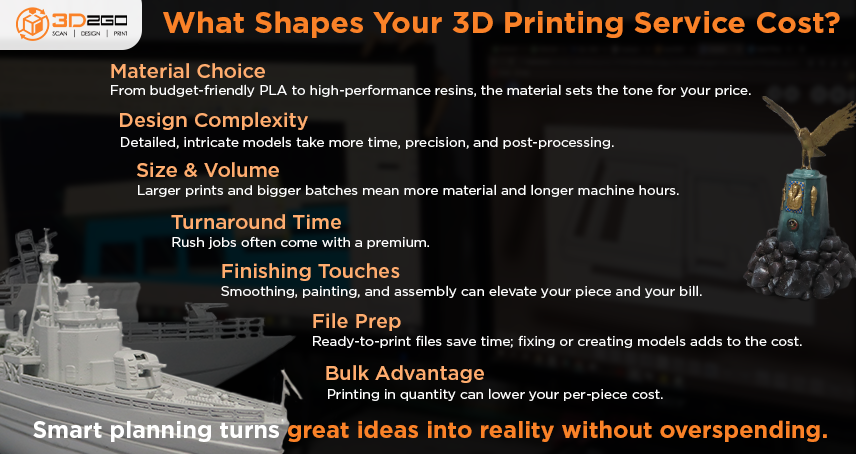
Getting the Most Out of Your Budget
Here are a few practical tips to keep costs in check without sacrificing quality:
-
Plan Ahead – Avoid rush fees by giving enough lead time.
-
Choose Materials Wisely – Match material to function; don’t overspend on properties you don’t need.
-
Simplify Where Possible – Reduce unnecessary complexity in your design.
-
Work with a Reliable Provider – Experience can prevent costly mistakes.
Understanding what influences the cost of 3D printing services enables you to make smarter choices from the outset.
Why Understanding Cost Factors Matters
3D printing isn’t just about hitting “print.” It’s a careful balance of design, material science, and production efficiency. By knowing what affects 3d printing service cost, you can make informed choices, set realistic budgets, and achieve your desired results without overspending.
The 3D2GO Advantage
At the end of the day, choosing the right partner is as important as the design itself. 3D2GO offers full end-to-end 3D printing solutions (from concept design to post-processing) so you get not just a printed part, but a finished product ready for use or display.
Our team can guide you in selecting the right materials, printing technology, and finishing options to meet your needs and budget. And because we handle everything in-house, you can trust that every detail is managed with care and precision.
Bring Your Ideas to Life Without Breaking the Bank
Whether you need a single prototype or a full production run, 3D2GO can help you get the most out of your budget. Contact us today for a detailed quote and see how we can turn your vision into reality.

